Analyzing the Organizational Culture of Zara: A Theoretical Framework Approach
VerifiedAdded on 2023/06/10
|14
|4291
|207
AI Summary
This report analyzes the organizational culture of Zara using Hofstede's Dimension theoretical framework. It discusses the company's background, culture, and environment. The report also justifies the chosen theoretical framework and highlights issues of discrimination faced by the company. It provides recommendations and conclusions based on the analysis. Course code, course name, and college/university are not mentioned.
Contribute Materials
Your contribution can guide someone’s learning journey. Share your
documents today.

RUNNING HEAD: Culture and organization 0
ZARA
Culture and organization
ZARA
Culture and organization
Secure Best Marks with AI Grader
Need help grading? Try our AI Grader for instant feedback on your assignments.
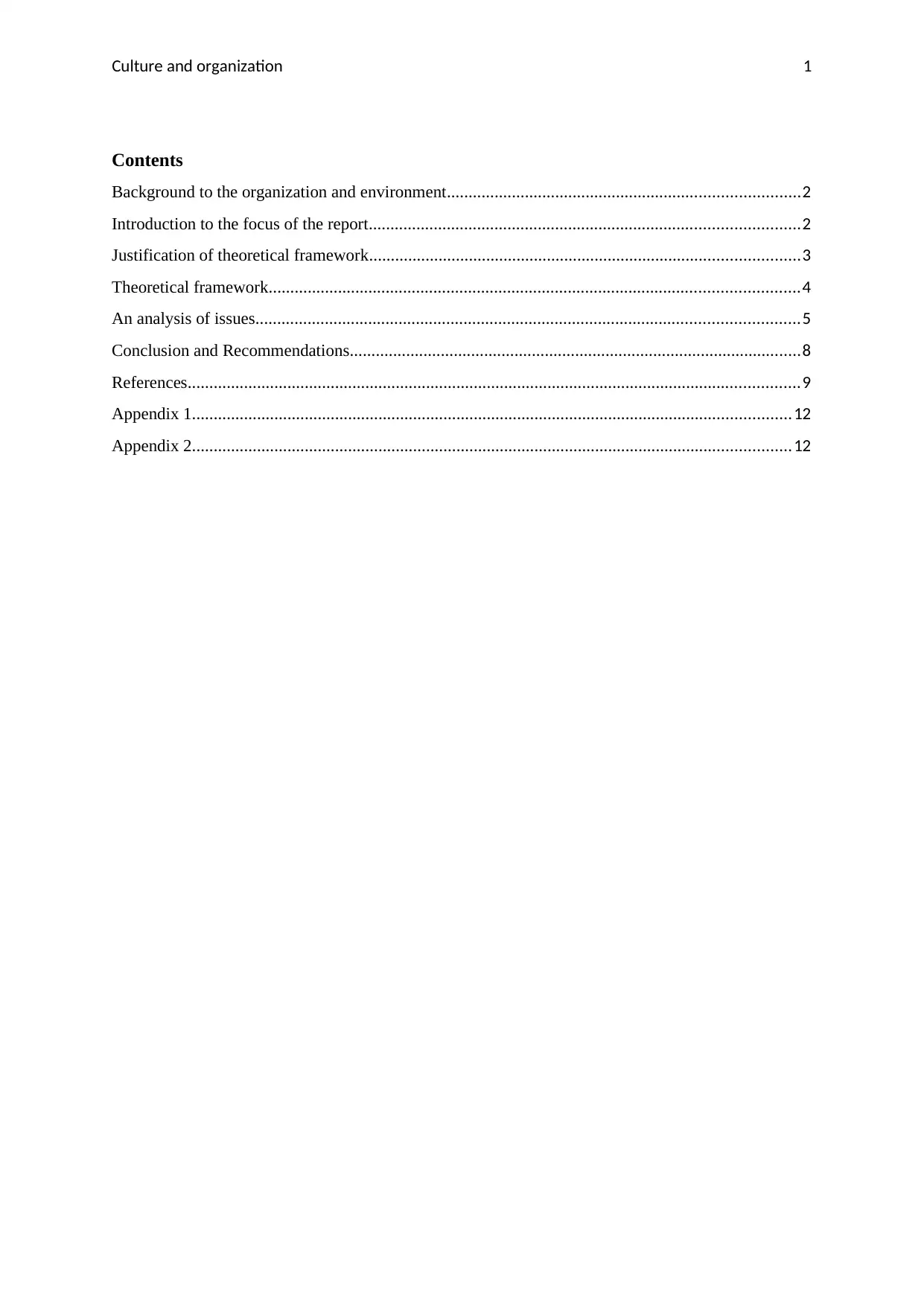
Culture and organization 1
Contents
Background to the organization and environment.................................................................................2
Introduction to the focus of the report...................................................................................................2
Justification of theoretical framework...................................................................................................3
Theoretical framework..........................................................................................................................4
An analysis of issues.............................................................................................................................5
Conclusion and Recommendations........................................................................................................8
References.............................................................................................................................................9
Appendix 1..........................................................................................................................................12
Appendix 2..........................................................................................................................................12
Contents
Background to the organization and environment.................................................................................2
Introduction to the focus of the report...................................................................................................2
Justification of theoretical framework...................................................................................................3
Theoretical framework..........................................................................................................................4
An analysis of issues.............................................................................................................................5
Conclusion and Recommendations........................................................................................................8
References.............................................................................................................................................9
Appendix 1..........................................................................................................................................12
Appendix 2..........................................................................................................................................12
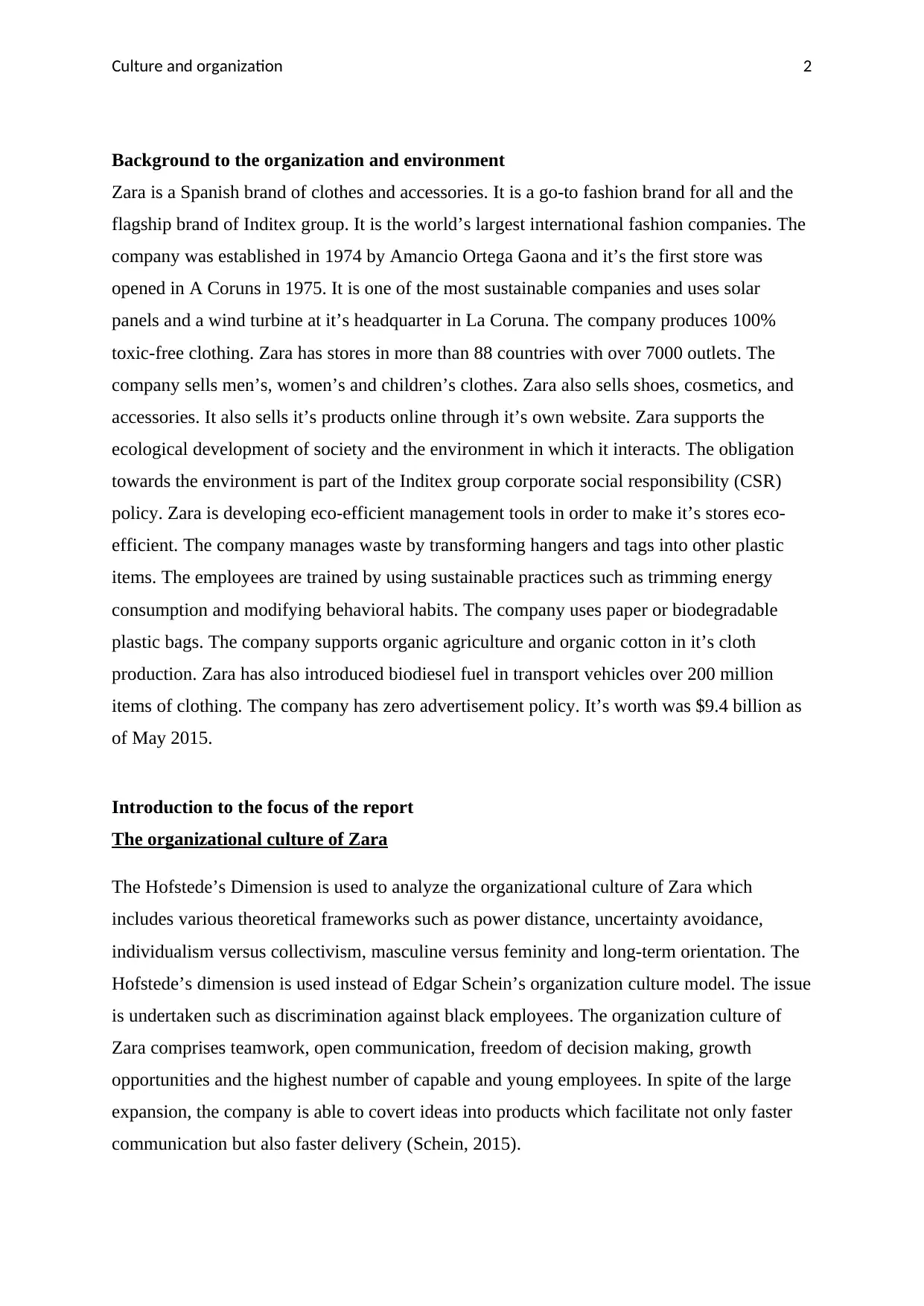
Culture and organization 2
Background to the organization and environment
Zara is a Spanish brand of clothes and accessories. It is a go-to fashion brand for all and the
flagship brand of Inditex group. It is the world’s largest international fashion companies. The
company was established in 1974 by Amancio Ortega Gaona and it’s the first store was
opened in A Coruns in 1975. It is one of the most sustainable companies and uses solar
panels and a wind turbine at it’s headquarter in La Coruna. The company produces 100%
toxic-free clothing. Zara has stores in more than 88 countries with over 7000 outlets. The
company sells men’s, women’s and children’s clothes. Zara also sells shoes, cosmetics, and
accessories. It also sells it’s products online through it’s own website. Zara supports the
ecological development of society and the environment in which it interacts. The obligation
towards the environment is part of the Inditex group corporate social responsibility (CSR)
policy. Zara is developing eco-efficient management tools in order to make it’s stores eco-
efficient. The company manages waste by transforming hangers and tags into other plastic
items. The employees are trained by using sustainable practices such as trimming energy
consumption and modifying behavioral habits. The company uses paper or biodegradable
plastic bags. The company supports organic agriculture and organic cotton in it’s cloth
production. Zara has also introduced biodiesel fuel in transport vehicles over 200 million
items of clothing. The company has zero advertisement policy. It’s worth was $9.4 billion as
of May 2015.
Introduction to the focus of the report
The organizational culture of Zara
The Hofstede’s Dimension is used to analyze the organizational culture of Zara which
includes various theoretical frameworks such as power distance, uncertainty avoidance,
individualism versus collectivism, masculine versus feminity and long-term orientation. The
Hofstede’s dimension is used instead of Edgar Schein’s organization culture model. The issue
is undertaken such as discrimination against black employees. The organization culture of
Zara comprises teamwork, open communication, freedom of decision making, growth
opportunities and the highest number of capable and young employees. In spite of the large
expansion, the company is able to covert ideas into products which facilitate not only faster
communication but also faster delivery (Schein, 2015).
Background to the organization and environment
Zara is a Spanish brand of clothes and accessories. It is a go-to fashion brand for all and the
flagship brand of Inditex group. It is the world’s largest international fashion companies. The
company was established in 1974 by Amancio Ortega Gaona and it’s the first store was
opened in A Coruns in 1975. It is one of the most sustainable companies and uses solar
panels and a wind turbine at it’s headquarter in La Coruna. The company produces 100%
toxic-free clothing. Zara has stores in more than 88 countries with over 7000 outlets. The
company sells men’s, women’s and children’s clothes. Zara also sells shoes, cosmetics, and
accessories. It also sells it’s products online through it’s own website. Zara supports the
ecological development of society and the environment in which it interacts. The obligation
towards the environment is part of the Inditex group corporate social responsibility (CSR)
policy. Zara is developing eco-efficient management tools in order to make it’s stores eco-
efficient. The company manages waste by transforming hangers and tags into other plastic
items. The employees are trained by using sustainable practices such as trimming energy
consumption and modifying behavioral habits. The company uses paper or biodegradable
plastic bags. The company supports organic agriculture and organic cotton in it’s cloth
production. Zara has also introduced biodiesel fuel in transport vehicles over 200 million
items of clothing. The company has zero advertisement policy. It’s worth was $9.4 billion as
of May 2015.
Introduction to the focus of the report
The organizational culture of Zara
The Hofstede’s Dimension is used to analyze the organizational culture of Zara which
includes various theoretical frameworks such as power distance, uncertainty avoidance,
individualism versus collectivism, masculine versus feminity and long-term orientation. The
Hofstede’s dimension is used instead of Edgar Schein’s organization culture model. The issue
is undertaken such as discrimination against black employees. The organization culture of
Zara comprises teamwork, open communication, freedom of decision making, growth
opportunities and the highest number of capable and young employees. In spite of the large
expansion, the company is able to covert ideas into products which facilitate not only faster
communication but also faster delivery (Schein, 2015).
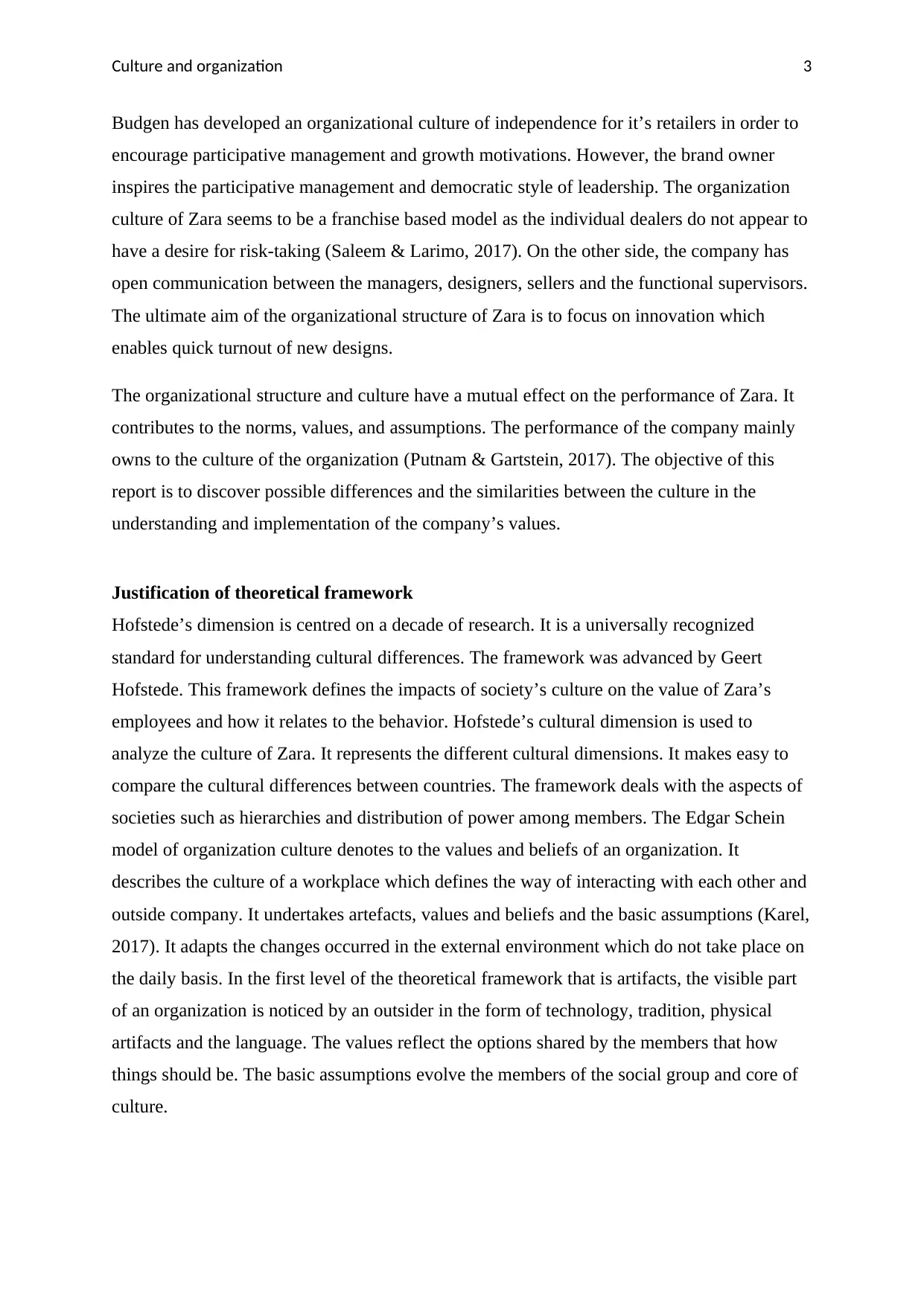
Culture and organization 3
Budgen has developed an organizational culture of independence for it’s retailers in order to
encourage participative management and growth motivations. However, the brand owner
inspires the participative management and democratic style of leadership. The organization
culture of Zara seems to be a franchise based model as the individual dealers do not appear to
have a desire for risk-taking (Saleem & Larimo, 2017). On the other side, the company has
open communication between the managers, designers, sellers and the functional supervisors.
The ultimate aim of the organizational structure of Zara is to focus on innovation which
enables quick turnout of new designs.
The organizational structure and culture have a mutual effect on the performance of Zara. It
contributes to the norms, values, and assumptions. The performance of the company mainly
owns to the culture of the organization (Putnam & Gartstein, 2017). The objective of this
report is to discover possible differences and the similarities between the culture in the
understanding and implementation of the company’s values.
Justification of theoretical framework
Hofstede’s dimension is centred on a decade of research. It is a universally recognized
standard for understanding cultural differences. The framework was advanced by Geert
Hofstede. This framework defines the impacts of society’s culture on the value of Zara’s
employees and how it relates to the behavior. Hofstede’s cultural dimension is used to
analyze the culture of Zara. It represents the different cultural dimensions. It makes easy to
compare the cultural differences between countries. The framework deals with the aspects of
societies such as hierarchies and distribution of power among members. The Edgar Schein
model of organization culture denotes to the values and beliefs of an organization. It
describes the culture of a workplace which defines the way of interacting with each other and
outside company. It undertakes artefacts, values and beliefs and the basic assumptions (Karel,
2017). It adapts the changes occurred in the external environment which do not take place on
the daily basis. In the first level of the theoretical framework that is artifacts, the visible part
of an organization is noticed by an outsider in the form of technology, tradition, physical
artifacts and the language. The values reflect the options shared by the members that how
things should be. The basic assumptions evolve the members of the social group and core of
culture.
Budgen has developed an organizational culture of independence for it’s retailers in order to
encourage participative management and growth motivations. However, the brand owner
inspires the participative management and democratic style of leadership. The organization
culture of Zara seems to be a franchise based model as the individual dealers do not appear to
have a desire for risk-taking (Saleem & Larimo, 2017). On the other side, the company has
open communication between the managers, designers, sellers and the functional supervisors.
The ultimate aim of the organizational structure of Zara is to focus on innovation which
enables quick turnout of new designs.
The organizational structure and culture have a mutual effect on the performance of Zara. It
contributes to the norms, values, and assumptions. The performance of the company mainly
owns to the culture of the organization (Putnam & Gartstein, 2017). The objective of this
report is to discover possible differences and the similarities between the culture in the
understanding and implementation of the company’s values.
Justification of theoretical framework
Hofstede’s dimension is centred on a decade of research. It is a universally recognized
standard for understanding cultural differences. The framework was advanced by Geert
Hofstede. This framework defines the impacts of society’s culture on the value of Zara’s
employees and how it relates to the behavior. Hofstede’s cultural dimension is used to
analyze the culture of Zara. It represents the different cultural dimensions. It makes easy to
compare the cultural differences between countries. The framework deals with the aspects of
societies such as hierarchies and distribution of power among members. The Edgar Schein
model of organization culture denotes to the values and beliefs of an organization. It
describes the culture of a workplace which defines the way of interacting with each other and
outside company. It undertakes artefacts, values and beliefs and the basic assumptions (Karel,
2017). It adapts the changes occurred in the external environment which do not take place on
the daily basis. In the first level of the theoretical framework that is artifacts, the visible part
of an organization is noticed by an outsider in the form of technology, tradition, physical
artifacts and the language. The values reflect the options shared by the members that how
things should be. The basic assumptions evolve the members of the social group and core of
culture.
Secure Best Marks with AI Grader
Need help grading? Try our AI Grader for instant feedback on your assignments.
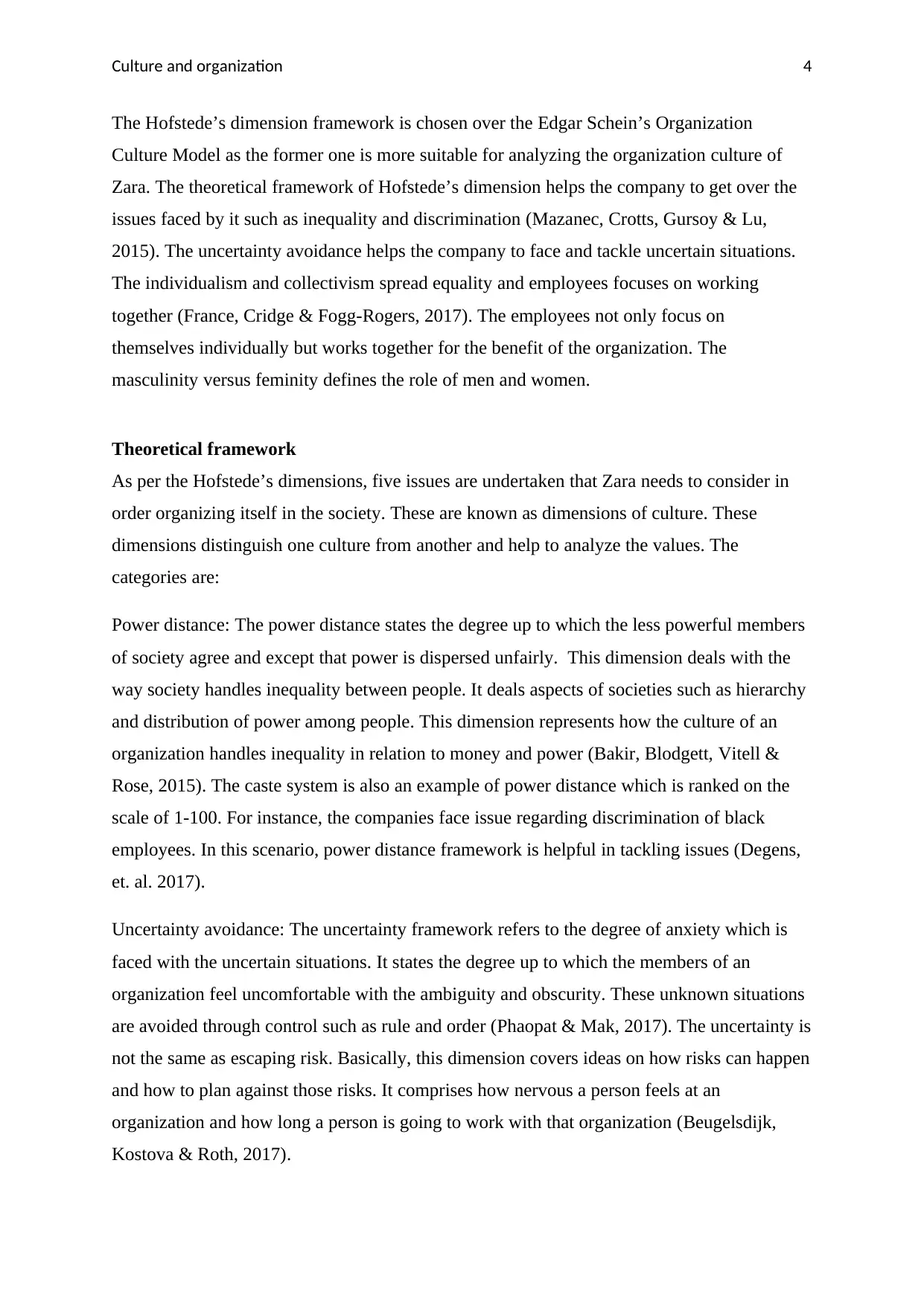
Culture and organization 4
The Hofstede’s dimension framework is chosen over the Edgar Schein’s Organization
Culture Model as the former one is more suitable for analyzing the organization culture of
Zara. The theoretical framework of Hofstede’s dimension helps the company to get over the
issues faced by it such as inequality and discrimination (Mazanec, Crotts, Gursoy & Lu,
2015). The uncertainty avoidance helps the company to face and tackle uncertain situations.
The individualism and collectivism spread equality and employees focuses on working
together (France, Cridge & Fogg-Rogers, 2017). The employees not only focus on
themselves individually but works together for the benefit of the organization. The
masculinity versus feminity defines the role of men and women.
Theoretical framework
As per the Hofstede’s dimensions, five issues are undertaken that Zara needs to consider in
order organizing itself in the society. These are known as dimensions of culture. These
dimensions distinguish one culture from another and help to analyze the values. The
categories are:
Power distance: The power distance states the degree up to which the less powerful members
of society agree and except that power is dispersed unfairly. This dimension deals with the
way society handles inequality between people. It deals aspects of societies such as hierarchy
and distribution of power among people. This dimension represents how the culture of an
organization handles inequality in relation to money and power (Bakir, Blodgett, Vitell &
Rose, 2015). The caste system is also an example of power distance which is ranked on the
scale of 1-100. For instance, the companies face issue regarding discrimination of black
employees. In this scenario, power distance framework is helpful in tackling issues (Degens,
et. al. 2017).
Uncertainty avoidance: The uncertainty framework refers to the degree of anxiety which is
faced with the uncertain situations. It states the degree up to which the members of an
organization feel uncomfortable with the ambiguity and obscurity. These unknown situations
are avoided through control such as rule and order (Phaopat & Mak, 2017). The uncertainty is
not the same as escaping risk. Basically, this dimension covers ideas on how risks can happen
and how to plan against those risks. It comprises how nervous a person feels at an
organization and how long a person is going to work with that organization (Beugelsdijk,
Kostova & Roth, 2017).
The Hofstede’s dimension framework is chosen over the Edgar Schein’s Organization
Culture Model as the former one is more suitable for analyzing the organization culture of
Zara. The theoretical framework of Hofstede’s dimension helps the company to get over the
issues faced by it such as inequality and discrimination (Mazanec, Crotts, Gursoy & Lu,
2015). The uncertainty avoidance helps the company to face and tackle uncertain situations.
The individualism and collectivism spread equality and employees focuses on working
together (France, Cridge & Fogg-Rogers, 2017). The employees not only focus on
themselves individually but works together for the benefit of the organization. The
masculinity versus feminity defines the role of men and women.
Theoretical framework
As per the Hofstede’s dimensions, five issues are undertaken that Zara needs to consider in
order organizing itself in the society. These are known as dimensions of culture. These
dimensions distinguish one culture from another and help to analyze the values. The
categories are:
Power distance: The power distance states the degree up to which the less powerful members
of society agree and except that power is dispersed unfairly. This dimension deals with the
way society handles inequality between people. It deals aspects of societies such as hierarchy
and distribution of power among people. This dimension represents how the culture of an
organization handles inequality in relation to money and power (Bakir, Blodgett, Vitell &
Rose, 2015). The caste system is also an example of power distance which is ranked on the
scale of 1-100. For instance, the companies face issue regarding discrimination of black
employees. In this scenario, power distance framework is helpful in tackling issues (Degens,
et. al. 2017).
Uncertainty avoidance: The uncertainty framework refers to the degree of anxiety which is
faced with the uncertain situations. It states the degree up to which the members of an
organization feel uncomfortable with the ambiguity and obscurity. These unknown situations
are avoided through control such as rule and order (Phaopat & Mak, 2017). The uncertainty is
not the same as escaping risk. Basically, this dimension covers ideas on how risks can happen
and how to plan against those risks. It comprises how nervous a person feels at an
organization and how long a person is going to work with that organization (Beugelsdijk,
Kostova & Roth, 2017).
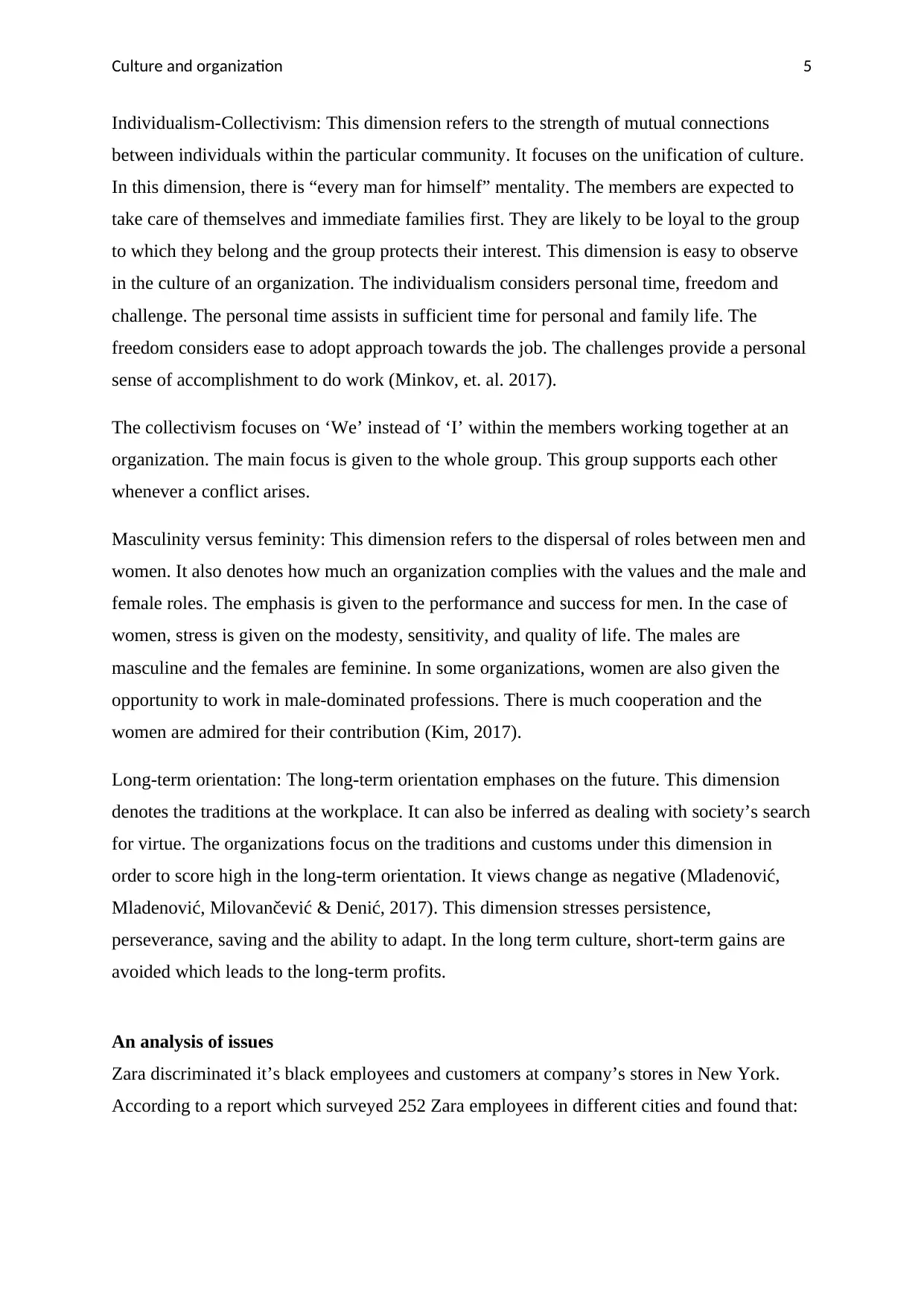
Culture and organization 5
Individualism-Collectivism: This dimension refers to the strength of mutual connections
between individuals within the particular community. It focuses on the unification of culture.
In this dimension, there is “every man for himself” mentality. The members are expected to
take care of themselves and immediate families first. They are likely to be loyal to the group
to which they belong and the group protects their interest. This dimension is easy to observe
in the culture of an organization. The individualism considers personal time, freedom and
challenge. The personal time assists in sufficient time for personal and family life. The
freedom considers ease to adopt approach towards the job. The challenges provide a personal
sense of accomplishment to do work (Minkov, et. al. 2017).
The collectivism focuses on ‘We’ instead of ‘I’ within the members working together at an
organization. The main focus is given to the whole group. This group supports each other
whenever a conflict arises.
Masculinity versus feminity: This dimension refers to the dispersal of roles between men and
women. It also denotes how much an organization complies with the values and the male and
female roles. The emphasis is given to the performance and success for men. In the case of
women, stress is given on the modesty, sensitivity, and quality of life. The males are
masculine and the females are feminine. In some organizations, women are also given the
opportunity to work in male-dominated professions. There is much cooperation and the
women are admired for their contribution (Kim, 2017).
Long-term orientation: The long-term orientation emphases on the future. This dimension
denotes the traditions at the workplace. It can also be inferred as dealing with society’s search
for virtue. The organizations focus on the traditions and customs under this dimension in
order to score high in the long-term orientation. It views change as negative (Mladenović,
Mladenović, Milovančević & Denić, 2017). This dimension stresses persistence,
perseverance, saving and the ability to adapt. In the long term culture, short-term gains are
avoided which leads to the long-term profits.
An analysis of issues
Zara discriminated it’s black employees and customers at company’s stores in New York.
According to a report which surveyed 252 Zara employees in different cities and found that:
Individualism-Collectivism: This dimension refers to the strength of mutual connections
between individuals within the particular community. It focuses on the unification of culture.
In this dimension, there is “every man for himself” mentality. The members are expected to
take care of themselves and immediate families first. They are likely to be loyal to the group
to which they belong and the group protects their interest. This dimension is easy to observe
in the culture of an organization. The individualism considers personal time, freedom and
challenge. The personal time assists in sufficient time for personal and family life. The
freedom considers ease to adopt approach towards the job. The challenges provide a personal
sense of accomplishment to do work (Minkov, et. al. 2017).
The collectivism focuses on ‘We’ instead of ‘I’ within the members working together at an
organization. The main focus is given to the whole group. This group supports each other
whenever a conflict arises.
Masculinity versus feminity: This dimension refers to the dispersal of roles between men and
women. It also denotes how much an organization complies with the values and the male and
female roles. The emphasis is given to the performance and success for men. In the case of
women, stress is given on the modesty, sensitivity, and quality of life. The males are
masculine and the females are feminine. In some organizations, women are also given the
opportunity to work in male-dominated professions. There is much cooperation and the
women are admired for their contribution (Kim, 2017).
Long-term orientation: The long-term orientation emphases on the future. This dimension
denotes the traditions at the workplace. It can also be inferred as dealing with society’s search
for virtue. The organizations focus on the traditions and customs under this dimension in
order to score high in the long-term orientation. It views change as negative (Mladenović,
Mladenović, Milovančević & Denić, 2017). This dimension stresses persistence,
perseverance, saving and the ability to adapt. In the long term culture, short-term gains are
avoided which leads to the long-term profits.
An analysis of issues
Zara discriminated it’s black employees and customers at company’s stores in New York.
According to a report which surveyed 252 Zara employees in different cities and found that:
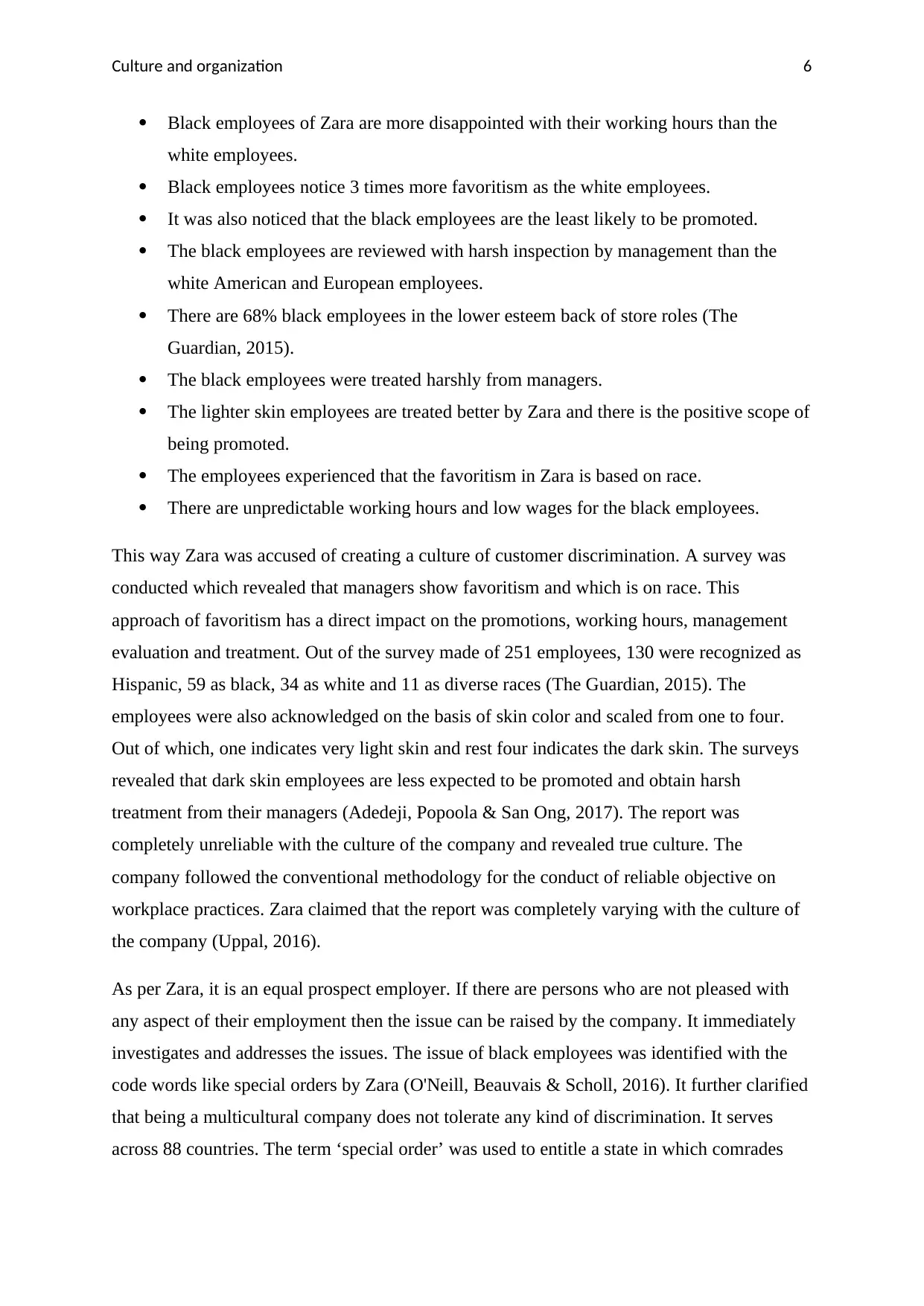
Culture and organization 6
Black employees of Zara are more disappointed with their working hours than the
white employees.
Black employees notice 3 times more favoritism as the white employees.
It was also noticed that the black employees are the least likely to be promoted.
The black employees are reviewed with harsh inspection by management than the
white American and European employees.
There are 68% black employees in the lower esteem back of store roles (The
Guardian, 2015).
The black employees were treated harshly from managers.
The lighter skin employees are treated better by Zara and there is the positive scope of
being promoted.
The employees experienced that the favoritism in Zara is based on race.
There are unpredictable working hours and low wages for the black employees.
This way Zara was accused of creating a culture of customer discrimination. A survey was
conducted which revealed that managers show favoritism and which is on race. This
approach of favoritism has a direct impact on the promotions, working hours, management
evaluation and treatment. Out of the survey made of 251 employees, 130 were recognized as
Hispanic, 59 as black, 34 as white and 11 as diverse races (The Guardian, 2015). The
employees were also acknowledged on the basis of skin color and scaled from one to four.
Out of which, one indicates very light skin and rest four indicates the dark skin. The surveys
revealed that dark skin employees are less expected to be promoted and obtain harsh
treatment from their managers (Adedeji, Popoola & San Ong, 2017). The report was
completely unreliable with the culture of the company and revealed true culture. The
company followed the conventional methodology for the conduct of reliable objective on
workplace practices. Zara claimed that the report was completely varying with the culture of
the company (Uppal, 2016).
As per Zara, it is an equal prospect employer. If there are persons who are not pleased with
any aspect of their employment then the issue can be raised by the company. It immediately
investigates and addresses the issues. The issue of black employees was identified with the
code words like special orders by Zara (O'Neill, Beauvais & Scholl, 2016). It further clarified
that being a multicultural company does not tolerate any kind of discrimination. It serves
across 88 countries. The term ‘special order’ was used to entitle a state in which comrades
Black employees of Zara are more disappointed with their working hours than the
white employees.
Black employees notice 3 times more favoritism as the white employees.
It was also noticed that the black employees are the least likely to be promoted.
The black employees are reviewed with harsh inspection by management than the
white American and European employees.
There are 68% black employees in the lower esteem back of store roles (The
Guardian, 2015).
The black employees were treated harshly from managers.
The lighter skin employees are treated better by Zara and there is the positive scope of
being promoted.
The employees experienced that the favoritism in Zara is based on race.
There are unpredictable working hours and low wages for the black employees.
This way Zara was accused of creating a culture of customer discrimination. A survey was
conducted which revealed that managers show favoritism and which is on race. This
approach of favoritism has a direct impact on the promotions, working hours, management
evaluation and treatment. Out of the survey made of 251 employees, 130 were recognized as
Hispanic, 59 as black, 34 as white and 11 as diverse races (The Guardian, 2015). The
employees were also acknowledged on the basis of skin color and scaled from one to four.
Out of which, one indicates very light skin and rest four indicates the dark skin. The surveys
revealed that dark skin employees are less expected to be promoted and obtain harsh
treatment from their managers (Adedeji, Popoola & San Ong, 2017). The report was
completely unreliable with the culture of the company and revealed true culture. The
company followed the conventional methodology for the conduct of reliable objective on
workplace practices. Zara claimed that the report was completely varying with the culture of
the company (Uppal, 2016).
As per Zara, it is an equal prospect employer. If there are persons who are not pleased with
any aspect of their employment then the issue can be raised by the company. It immediately
investigates and addresses the issues. The issue of black employees was identified with the
code words like special orders by Zara (O'Neill, Beauvais & Scholl, 2016). It further clarified
that being a multicultural company does not tolerate any kind of discrimination. It serves
across 88 countries. The term ‘special order’ was used to entitle a state in which comrades
Paraphrase This Document
Need a fresh take? Get an instant paraphrase of this document with our AI Paraphraser

Culture and organization 7
were wished to enforce customer service and zone attention on the floor. It does not entitle an
individual or group of any category (Martinez, et. al. 2015).
The company provides clarification on the discrimination in promotions. Zara claimed that it
promoted approximately half Hisapanic employees. On the other side, half of the hours are
assigned to the Hisapanic employees. These actualities represented that multiplicity and equal
opportunity are the core values of the company (Al Saifi, 2015). As per the records of the
company, half of it’s employees are Hispanic.
The company faced a lawsuit of $40 million against the discrimination by Ian Miller in 2008
(The Guardian, 2015). According to this lawsuit, Miller who was an American and gay was
debarred from all the meetings and exposed to discriminatory, homophobic and anti-Semitic
remarks. It did not refer to the preferred profile of the company. He also complained that the
harassers were threatened with punishment by the founder of the company (Arifin, 2014).
The New York city laws prohibit wage discrimination, wrong release, reprisal and
antagonistic work environment. The discernment infiltrated the whole company. The
corporate culture is very challenging. The lawsuits exposed the discrimination which
pervaded Zara USA. As per the revelations made by the lawsuits, it is significant to reflect
that it occurs across all levels.
Various lawsuits were also filed against Zara on a number of events. The company was
condemned for selling items with ethnically oblivious designs. Bags embellished with
swastikas (symbol represents religion) were dragged from stores after a complaint filed in
2007. The company sold necklaces with porcelains in 2013. The company also faced
criticism for the 2 different designs, one stripped and embellished with a gold star which look
like outfits worn by Jewish victims. The second was white tee-shirt which displayed the
words “White is the New Black”.
There were also recent disagreements over racism in the retail sector of New York. The
department stores of New York, Macy’s and Barneys faced an inquiry from the state
prosecutor general after several acquisitions from customers based on the discriminations
(Oyewobi, Abiola Falemu & Ibironke, 2016). Macy’s and Barneys were settled for $650,000
and $525,000 in August 2014 (The Guardian, 2015).
The analysis of the practices of Zara can be made by using Global cultural dimensions. The
theoretical framework such as power distance can be useful for Zara in dealing with the
were wished to enforce customer service and zone attention on the floor. It does not entitle an
individual or group of any category (Martinez, et. al. 2015).
The company provides clarification on the discrimination in promotions. Zara claimed that it
promoted approximately half Hisapanic employees. On the other side, half of the hours are
assigned to the Hisapanic employees. These actualities represented that multiplicity and equal
opportunity are the core values of the company (Al Saifi, 2015). As per the records of the
company, half of it’s employees are Hispanic.
The company faced a lawsuit of $40 million against the discrimination by Ian Miller in 2008
(The Guardian, 2015). According to this lawsuit, Miller who was an American and gay was
debarred from all the meetings and exposed to discriminatory, homophobic and anti-Semitic
remarks. It did not refer to the preferred profile of the company. He also complained that the
harassers were threatened with punishment by the founder of the company (Arifin, 2014).
The New York city laws prohibit wage discrimination, wrong release, reprisal and
antagonistic work environment. The discernment infiltrated the whole company. The
corporate culture is very challenging. The lawsuits exposed the discrimination which
pervaded Zara USA. As per the revelations made by the lawsuits, it is significant to reflect
that it occurs across all levels.
Various lawsuits were also filed against Zara on a number of events. The company was
condemned for selling items with ethnically oblivious designs. Bags embellished with
swastikas (symbol represents religion) were dragged from stores after a complaint filed in
2007. The company sold necklaces with porcelains in 2013. The company also faced
criticism for the 2 different designs, one stripped and embellished with a gold star which look
like outfits worn by Jewish victims. The second was white tee-shirt which displayed the
words “White is the New Black”.
There were also recent disagreements over racism in the retail sector of New York. The
department stores of New York, Macy’s and Barneys faced an inquiry from the state
prosecutor general after several acquisitions from customers based on the discriminations
(Oyewobi, Abiola Falemu & Ibironke, 2016). Macy’s and Barneys were settled for $650,000
and $525,000 in August 2014 (The Guardian, 2015).
The analysis of the practices of Zara can be made by using Global cultural dimensions. The
theoretical framework such as power distance can be useful for Zara in dealing with the
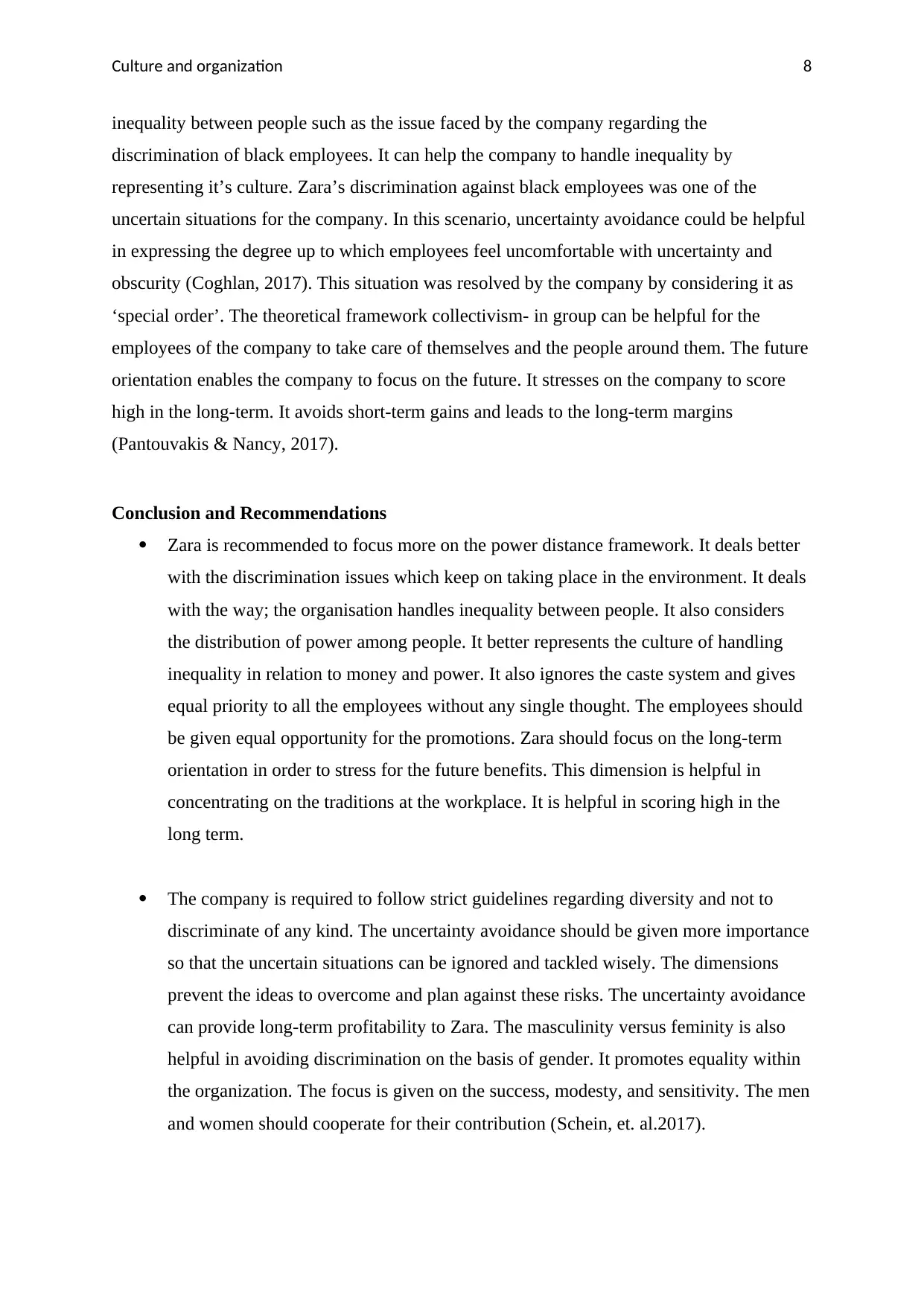
Culture and organization 8
inequality between people such as the issue faced by the company regarding the
discrimination of black employees. It can help the company to handle inequality by
representing it’s culture. Zara’s discrimination against black employees was one of the
uncertain situations for the company. In this scenario, uncertainty avoidance could be helpful
in expressing the degree up to which employees feel uncomfortable with uncertainty and
obscurity (Coghlan, 2017). This situation was resolved by the company by considering it as
‘special order’. The theoretical framework collectivism- in group can be helpful for the
employees of the company to take care of themselves and the people around them. The future
orientation enables the company to focus on the future. It stresses on the company to score
high in the long-term. It avoids short-term gains and leads to the long-term margins
(Pantouvakis & Nancy, 2017).
Conclusion and Recommendations
Zara is recommended to focus more on the power distance framework. It deals better
with the discrimination issues which keep on taking place in the environment. It deals
with the way; the organisation handles inequality between people. It also considers
the distribution of power among people. It better represents the culture of handling
inequality in relation to money and power. It also ignores the caste system and gives
equal priority to all the employees without any single thought. The employees should
be given equal opportunity for the promotions. Zara should focus on the long-term
orientation in order to stress for the future benefits. This dimension is helpful in
concentrating on the traditions at the workplace. It is helpful in scoring high in the
long term.
The company is required to follow strict guidelines regarding diversity and not to
discriminate of any kind. The uncertainty avoidance should be given more importance
so that the uncertain situations can be ignored and tackled wisely. The dimensions
prevent the ideas to overcome and plan against these risks. The uncertainty avoidance
can provide long-term profitability to Zara. The masculinity versus feminity is also
helpful in avoiding discrimination on the basis of gender. It promotes equality within
the organization. The focus is given on the success, modesty, and sensitivity. The men
and women should cooperate for their contribution (Schein, et. al.2017).
inequality between people such as the issue faced by the company regarding the
discrimination of black employees. It can help the company to handle inequality by
representing it’s culture. Zara’s discrimination against black employees was one of the
uncertain situations for the company. In this scenario, uncertainty avoidance could be helpful
in expressing the degree up to which employees feel uncomfortable with uncertainty and
obscurity (Coghlan, 2017). This situation was resolved by the company by considering it as
‘special order’. The theoretical framework collectivism- in group can be helpful for the
employees of the company to take care of themselves and the people around them. The future
orientation enables the company to focus on the future. It stresses on the company to score
high in the long-term. It avoids short-term gains and leads to the long-term margins
(Pantouvakis & Nancy, 2017).
Conclusion and Recommendations
Zara is recommended to focus more on the power distance framework. It deals better
with the discrimination issues which keep on taking place in the environment. It deals
with the way; the organisation handles inequality between people. It also considers
the distribution of power among people. It better represents the culture of handling
inequality in relation to money and power. It also ignores the caste system and gives
equal priority to all the employees without any single thought. The employees should
be given equal opportunity for the promotions. Zara should focus on the long-term
orientation in order to stress for the future benefits. This dimension is helpful in
concentrating on the traditions at the workplace. It is helpful in scoring high in the
long term.
The company is required to follow strict guidelines regarding diversity and not to
discriminate of any kind. The uncertainty avoidance should be given more importance
so that the uncertain situations can be ignored and tackled wisely. The dimensions
prevent the ideas to overcome and plan against these risks. The uncertainty avoidance
can provide long-term profitability to Zara. The masculinity versus feminity is also
helpful in avoiding discrimination on the basis of gender. It promotes equality within
the organization. The focus is given on the success, modesty, and sensitivity. The men
and women should cooperate for their contribution (Schein, et. al.2017).
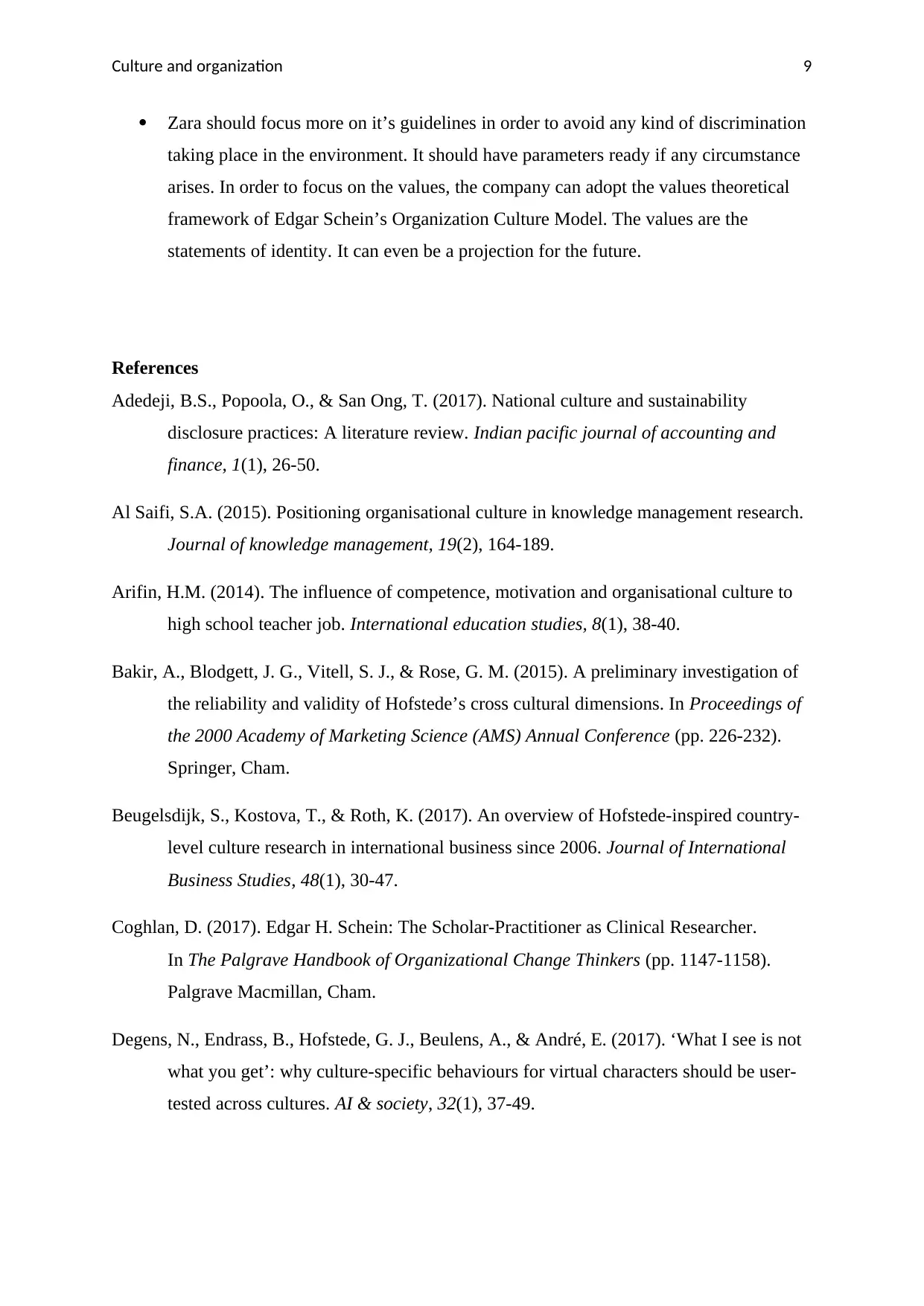
Culture and organization 9
Zara should focus more on it’s guidelines in order to avoid any kind of discrimination
taking place in the environment. It should have parameters ready if any circumstance
arises. In order to focus on the values, the company can adopt the values theoretical
framework of Edgar Schein’s Organization Culture Model. The values are the
statements of identity. It can even be a projection for the future.
References
Adedeji, B.S., Popoola, O., & San Ong, T. (2017). National culture and sustainability
disclosure practices: A literature review. Indian pacific journal of accounting and
finance, 1(1), 26-50.
Al Saifi, S.A. (2015). Positioning organisational culture in knowledge management research.
Journal of knowledge management, 19(2), 164-189.
Arifin, H.M. (2014). The influence of competence, motivation and organisational culture to
high school teacher job. International education studies, 8(1), 38-40.
Bakir, A., Blodgett, J. G., Vitell, S. J., & Rose, G. M. (2015). A preliminary investigation of
the reliability and validity of Hofstede’s cross cultural dimensions. In Proceedings of
the 2000 Academy of Marketing Science (AMS) Annual Conference (pp. 226-232).
Springer, Cham.
Beugelsdijk, S., Kostova, T., & Roth, K. (2017). An overview of Hofstede-inspired country-
level culture research in international business since 2006. Journal of International
Business Studies, 48(1), 30-47.
Coghlan, D. (2017). Edgar H. Schein: The Scholar-Practitioner as Clinical Researcher.
In The Palgrave Handbook of Organizational Change Thinkers (pp. 1147-1158).
Palgrave Macmillan, Cham.
Degens, N., Endrass, B., Hofstede, G. J., Beulens, A., & André, E. (2017). ‘What I see is not
what you get’: why culture-specific behaviours for virtual characters should be user-
tested across cultures. AI & society, 32(1), 37-49.
Zara should focus more on it’s guidelines in order to avoid any kind of discrimination
taking place in the environment. It should have parameters ready if any circumstance
arises. In order to focus on the values, the company can adopt the values theoretical
framework of Edgar Schein’s Organization Culture Model. The values are the
statements of identity. It can even be a projection for the future.
References
Adedeji, B.S., Popoola, O., & San Ong, T. (2017). National culture and sustainability
disclosure practices: A literature review. Indian pacific journal of accounting and
finance, 1(1), 26-50.
Al Saifi, S.A. (2015). Positioning organisational culture in knowledge management research.
Journal of knowledge management, 19(2), 164-189.
Arifin, H.M. (2014). The influence of competence, motivation and organisational culture to
high school teacher job. International education studies, 8(1), 38-40.
Bakir, A., Blodgett, J. G., Vitell, S. J., & Rose, G. M. (2015). A preliminary investigation of
the reliability and validity of Hofstede’s cross cultural dimensions. In Proceedings of
the 2000 Academy of Marketing Science (AMS) Annual Conference (pp. 226-232).
Springer, Cham.
Beugelsdijk, S., Kostova, T., & Roth, K. (2017). An overview of Hofstede-inspired country-
level culture research in international business since 2006. Journal of International
Business Studies, 48(1), 30-47.
Coghlan, D. (2017). Edgar H. Schein: The Scholar-Practitioner as Clinical Researcher.
In The Palgrave Handbook of Organizational Change Thinkers (pp. 1147-1158).
Palgrave Macmillan, Cham.
Degens, N., Endrass, B., Hofstede, G. J., Beulens, A., & André, E. (2017). ‘What I see is not
what you get’: why culture-specific behaviours for virtual characters should be user-
tested across cultures. AI & society, 32(1), 37-49.
Secure Best Marks with AI Grader
Need help grading? Try our AI Grader for instant feedback on your assignments.
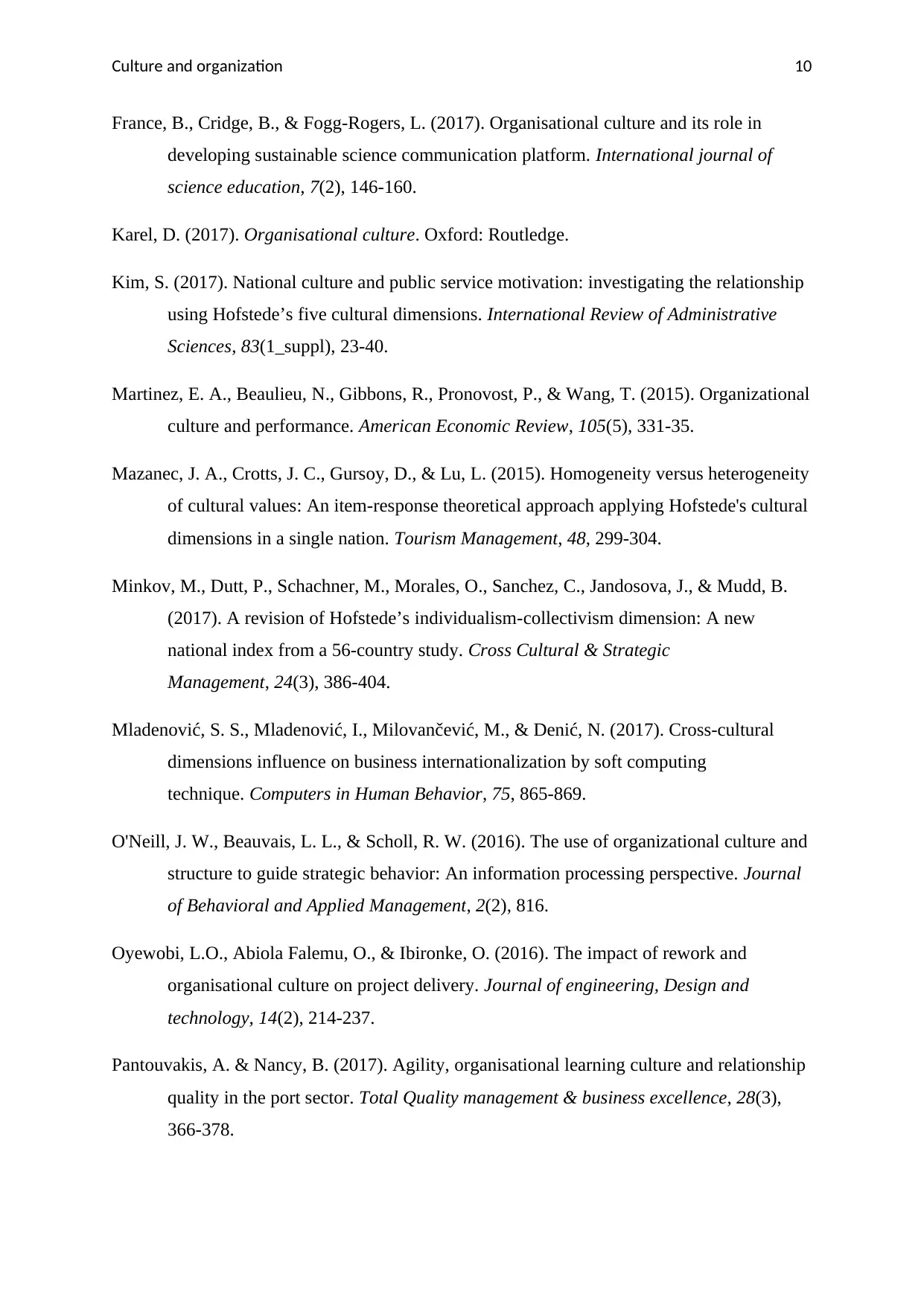
Culture and organization 10
France, B., Cridge, B., & Fogg-Rogers, L. (2017). Organisational culture and its role in
developing sustainable science communication platform. International journal of
science education, 7(2), 146-160.
Karel, D. (2017). Organisational culture. Oxford: Routledge.
Kim, S. (2017). National culture and public service motivation: investigating the relationship
using Hofstede’s five cultural dimensions. International Review of Administrative
Sciences, 83(1_suppl), 23-40.
Martinez, E. A., Beaulieu, N., Gibbons, R., Pronovost, P., & Wang, T. (2015). Organizational
culture and performance. American Economic Review, 105(5), 331-35.
Mazanec, J. A., Crotts, J. C., Gursoy, D., & Lu, L. (2015). Homogeneity versus heterogeneity
of cultural values: An item-response theoretical approach applying Hofstede's cultural
dimensions in a single nation. Tourism Management, 48, 299-304.
Minkov, M., Dutt, P., Schachner, M., Morales, O., Sanchez, C., Jandosova, J., & Mudd, B.
(2017). A revision of Hofstede’s individualism-collectivism dimension: A new
national index from a 56-country study. Cross Cultural & Strategic
Management, 24(3), 386-404.
Mladenović, S. S., Mladenović, I., Milovančević, M., & Denić, N. (2017). Cross-cultural
dimensions influence on business internationalization by soft computing
technique. Computers in Human Behavior, 75, 865-869.
O'Neill, J. W., Beauvais, L. L., & Scholl, R. W. (2016). The use of organizational culture and
structure to guide strategic behavior: An information processing perspective. Journal
of Behavioral and Applied Management, 2(2), 816.
Oyewobi, L.O., Abiola Falemu, O., & Ibironke, O. (2016). The impact of rework and
organisational culture on project delivery. Journal of engineering, Design and
technology, 14(2), 214-237.
Pantouvakis, A. & Nancy, B. (2017). Agility, organisational learning culture and relationship
quality in the port sector. Total Quality management & business excellence, 28(3),
366-378.
France, B., Cridge, B., & Fogg-Rogers, L. (2017). Organisational culture and its role in
developing sustainable science communication platform. International journal of
science education, 7(2), 146-160.
Karel, D. (2017). Organisational culture. Oxford: Routledge.
Kim, S. (2017). National culture and public service motivation: investigating the relationship
using Hofstede’s five cultural dimensions. International Review of Administrative
Sciences, 83(1_suppl), 23-40.
Martinez, E. A., Beaulieu, N., Gibbons, R., Pronovost, P., & Wang, T. (2015). Organizational
culture and performance. American Economic Review, 105(5), 331-35.
Mazanec, J. A., Crotts, J. C., Gursoy, D., & Lu, L. (2015). Homogeneity versus heterogeneity
of cultural values: An item-response theoretical approach applying Hofstede's cultural
dimensions in a single nation. Tourism Management, 48, 299-304.
Minkov, M., Dutt, P., Schachner, M., Morales, O., Sanchez, C., Jandosova, J., & Mudd, B.
(2017). A revision of Hofstede’s individualism-collectivism dimension: A new
national index from a 56-country study. Cross Cultural & Strategic
Management, 24(3), 386-404.
Mladenović, S. S., Mladenović, I., Milovančević, M., & Denić, N. (2017). Cross-cultural
dimensions influence on business internationalization by soft computing
technique. Computers in Human Behavior, 75, 865-869.
O'Neill, J. W., Beauvais, L. L., & Scholl, R. W. (2016). The use of organizational culture and
structure to guide strategic behavior: An information processing perspective. Journal
of Behavioral and Applied Management, 2(2), 816.
Oyewobi, L.O., Abiola Falemu, O., & Ibironke, O. (2016). The impact of rework and
organisational culture on project delivery. Journal of engineering, Design and
technology, 14(2), 214-237.
Pantouvakis, A. & Nancy, B. (2017). Agility, organisational learning culture and relationship
quality in the port sector. Total Quality management & business excellence, 28(3),
366-378.
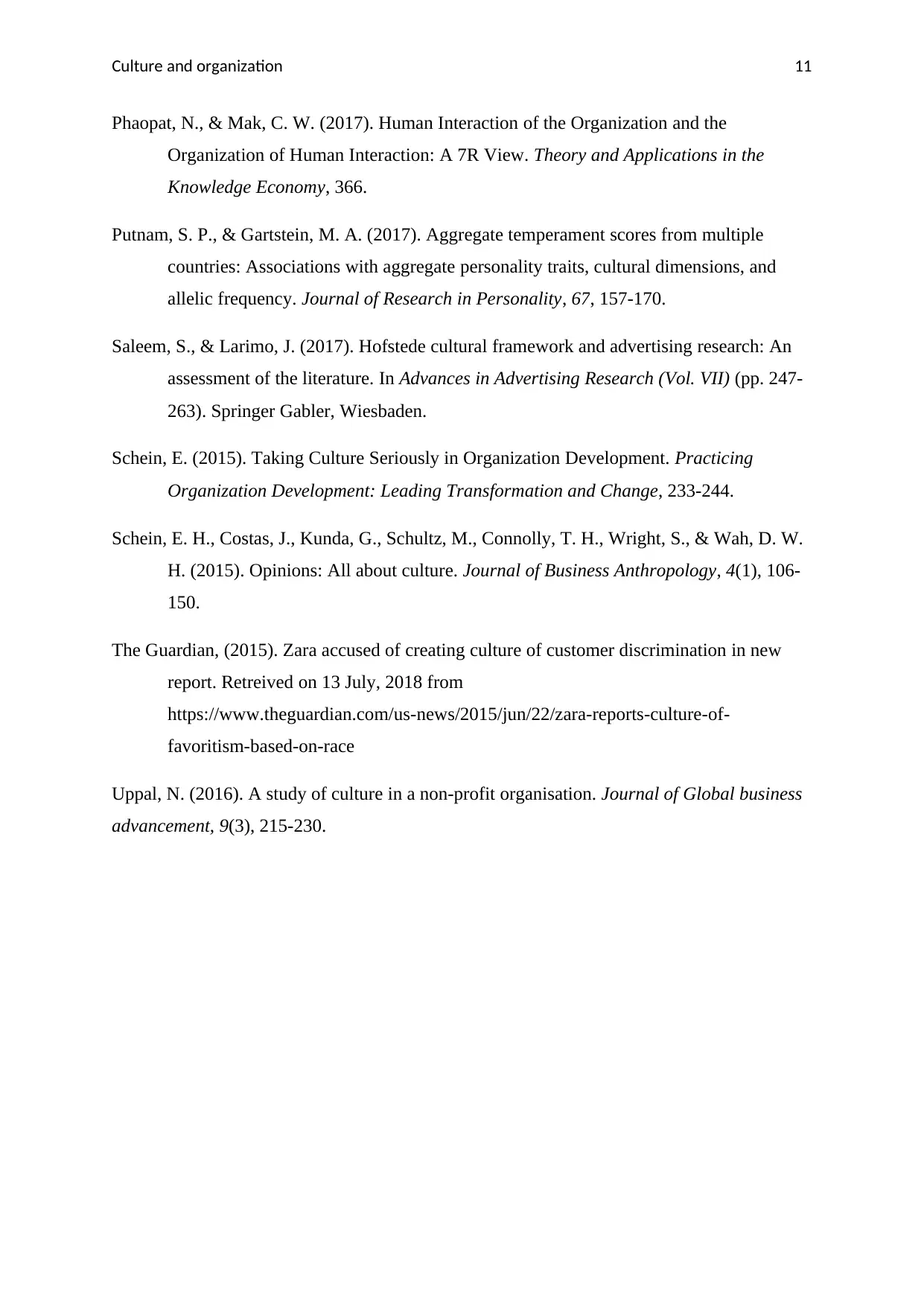
Culture and organization 11
Phaopat, N., & Mak, C. W. (2017). Human Interaction of the Organization and the
Organization of Human Interaction: A 7R View. Theory and Applications in the
Knowledge Economy, 366.
Putnam, S. P., & Gartstein, M. A. (2017). Aggregate temperament scores from multiple
countries: Associations with aggregate personality traits, cultural dimensions, and
allelic frequency. Journal of Research in Personality, 67, 157-170.
Saleem, S., & Larimo, J. (2017). Hofstede cultural framework and advertising research: An
assessment of the literature. In Advances in Advertising Research (Vol. VII) (pp. 247-
263). Springer Gabler, Wiesbaden.
Schein, E. (2015). Taking Culture Seriously in Organization Development. Practicing
Organization Development: Leading Transformation and Change, 233-244.
Schein, E. H., Costas, J., Kunda, G., Schultz, M., Connolly, T. H., Wright, S., & Wah, D. W.
H. (2015). Opinions: All about culture. Journal of Business Anthropology, 4(1), 106-
150.
The Guardian, (2015). Zara accused of creating culture of customer discrimination in new
report. Retreived on 13 July, 2018 from
https://www.theguardian.com/us-news/2015/jun/22/zara-reports-culture-of-
favoritism-based-on-race
Uppal, N. (2016). A study of culture in a non-profit organisation. Journal of Global business
advancement, 9(3), 215-230.
Phaopat, N., & Mak, C. W. (2017). Human Interaction of the Organization and the
Organization of Human Interaction: A 7R View. Theory and Applications in the
Knowledge Economy, 366.
Putnam, S. P., & Gartstein, M. A. (2017). Aggregate temperament scores from multiple
countries: Associations with aggregate personality traits, cultural dimensions, and
allelic frequency. Journal of Research in Personality, 67, 157-170.
Saleem, S., & Larimo, J. (2017). Hofstede cultural framework and advertising research: An
assessment of the literature. In Advances in Advertising Research (Vol. VII) (pp. 247-
263). Springer Gabler, Wiesbaden.
Schein, E. (2015). Taking Culture Seriously in Organization Development. Practicing
Organization Development: Leading Transformation and Change, 233-244.
Schein, E. H., Costas, J., Kunda, G., Schultz, M., Connolly, T. H., Wright, S., & Wah, D. W.
H. (2015). Opinions: All about culture. Journal of Business Anthropology, 4(1), 106-
150.
The Guardian, (2015). Zara accused of creating culture of customer discrimination in new
report. Retreived on 13 July, 2018 from
https://www.theguardian.com/us-news/2015/jun/22/zara-reports-culture-of-
favoritism-based-on-race
Uppal, N. (2016). A study of culture in a non-profit organisation. Journal of Global business
advancement, 9(3), 215-230.
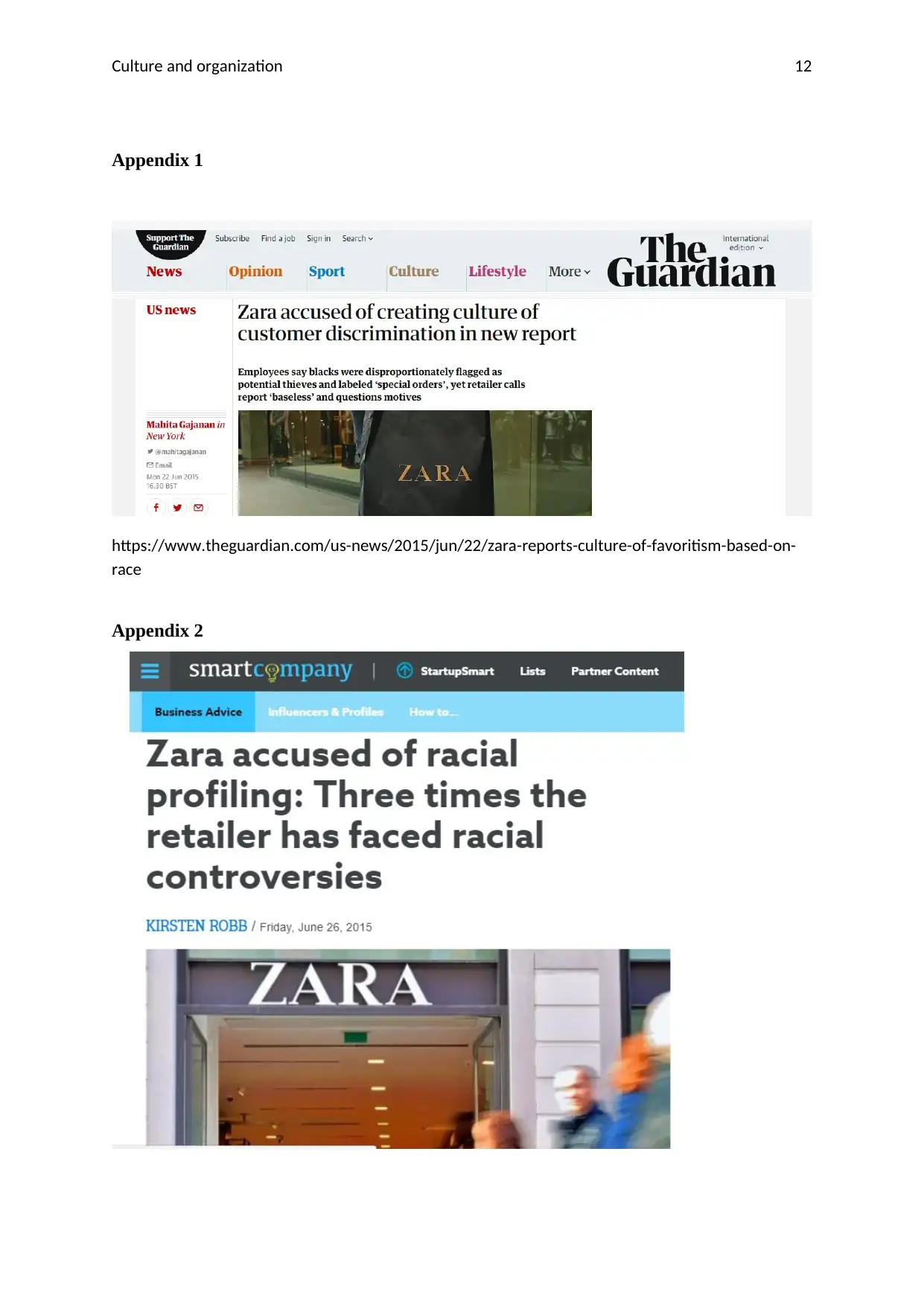
Culture and organization 12
Appendix 1
https://www.theguardian.com/us-news/2015/jun/22/zara-reports-culture-of-favoritism-based-on-
race
Appendix 2
Appendix 1
https://www.theguardian.com/us-news/2015/jun/22/zara-reports-culture-of-favoritism-based-on-
race
Appendix 2
Paraphrase This Document
Need a fresh take? Get an instant paraphrase of this document with our AI Paraphraser
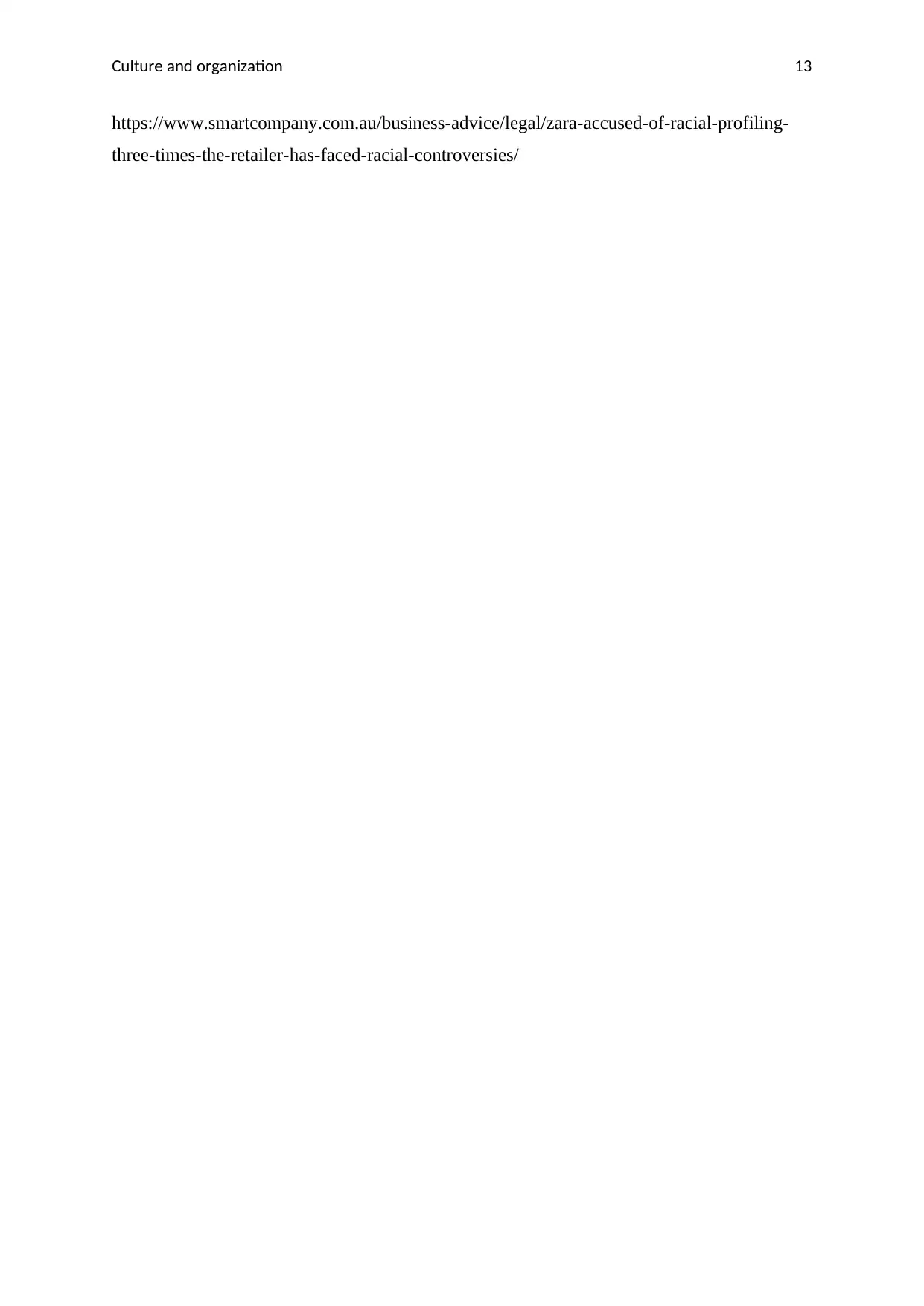
Culture and organization 13
https://www.smartcompany.com.au/business-advice/legal/zara-accused-of-racial-profiling-
three-times-the-retailer-has-faced-racial-controversies/
https://www.smartcompany.com.au/business-advice/legal/zara-accused-of-racial-profiling-
three-times-the-retailer-has-faced-racial-controversies/
1 out of 14
Related Documents
Your All-in-One AI-Powered Toolkit for Academic Success.
+13062052269
info@desklib.com
Available 24*7 on WhatsApp / Email
![[object Object]](/_next/static/media/star-bottom.7253800d.svg)
Unlock your academic potential
© 2024 | Zucol Services PVT LTD | All rights reserved.





